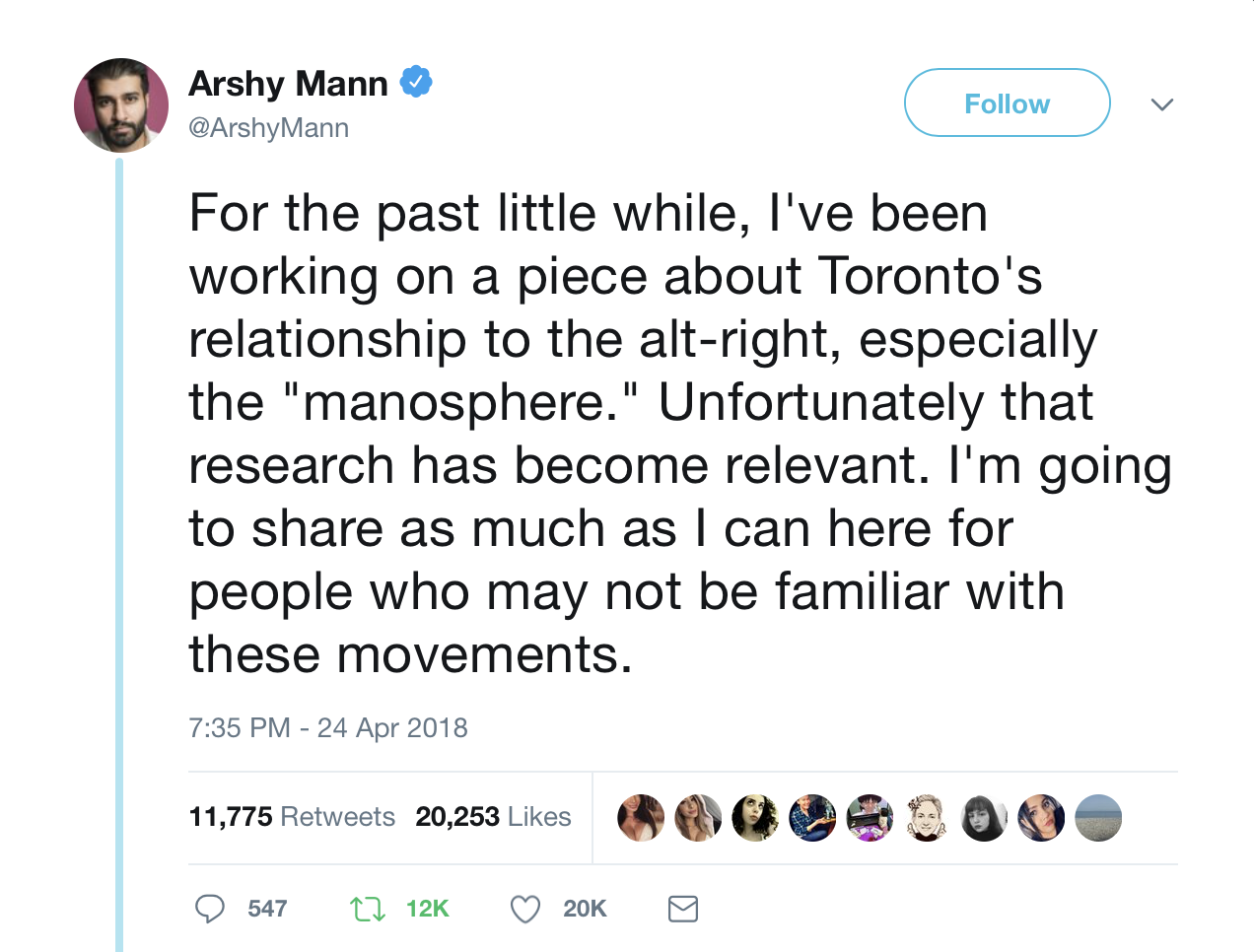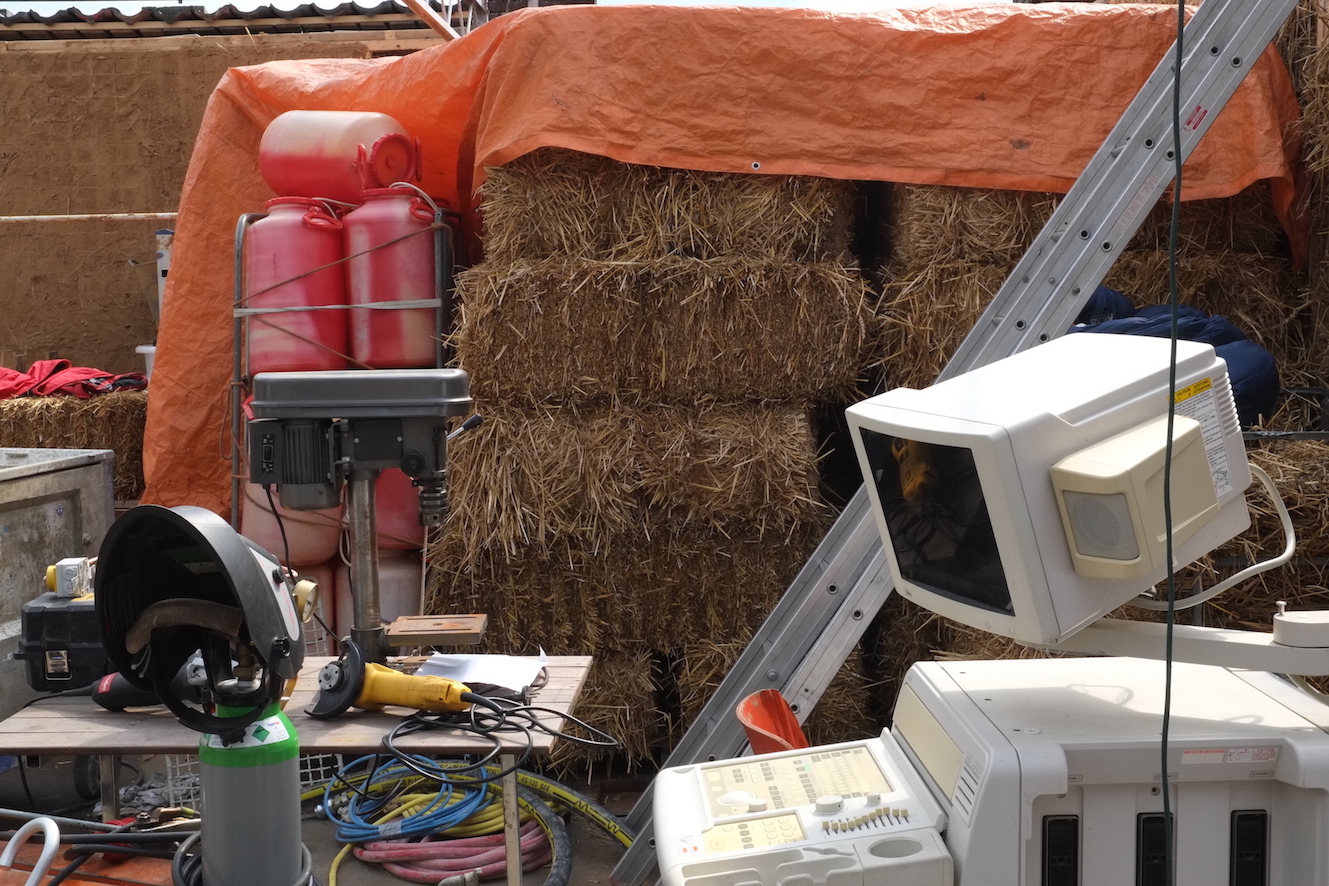An annotated (and very select) bibliography
There is much interest in changing production and consumption patterns today, whether you want to call it the New Industrial Revolution, the Third Industrial Revolution, Industrie 4.0, the Sharing Economy, the Maker Economy, Mass Innovation – whatever. Of course the interest is related to money and (usually elites) making it, but there are a few of us who also see there could be social and environmental benefits to these phenomena – making a better world.
So there are a lot of ifs, cans and shoulds in the literature, even in the academic stuff. There just isn’t enough empirical research done, in my view, in the rush to produce conceptual frameworks, and the empirical research that is done faces the common problem of generalizability. In some of the empirical studies I’ve seen, there aren’t enough case studies to be able to report patterns or reliably report barriers, or in other studies a few case studies are presented that aren’t analysed (or conveyed) deeply and richly enough for their small number, or the case studies rely on only one channel for data, e.g. interviews or, even worse, websites. But to be fair, it’s not an easy thing to study as an emerging and changing phenomenon: what is the baseline case? What are we comparing against? Are we making improvements or just romantic gestures? And it’s not an easy thing to foster: the whole point (for some of us) is to aim for radical innovation, not only make incremental improvements that serve business-as-usual.
In the LeNSin project, we are examining these phenomena from the point of view of design-for-sustainability education. LeNSin (international Learning Network on Sustainability) is an Erasmus+ funded project that focuses on capacity building for design teachers in South Africa, China, Mexico, India and Brazil. As a learning network, we have been examining how to design and teach sustainable Product-Service Systems (S.PSS) for about 10 years. Now we are also looking at the concept of Distributed Economies (DE) and how DE may connect to S.PSS, especially in these varied non-European contexts. For example, many of our partners’ cities already have collaborative and/or eco-efficient services where certain things are localized and distributed (bringing home local value according to DE principles), and certain things are shared and optimized (encouraging dematerialization of well-being according to S.PSS principles). How can we encourage these positive examples in our home regions, and how can we design and implement them with stakeholders in regions where they don’t exist but have potential to thrive?
As a teaching community, however, this noble ideal means we need to establish some conceptual, theoretical and empirical ground that does not yet exist or is extremely nascent and fragmented. Before we can understand the relationships between DE and S.PSS, we need to understand what DE can be for our project.
(I’m not going to get into the whys and wherefores of S.PSS here – we have written extensively on studying, teaching, learning and implementing S.PSS here and here.)
As a starting point in the project we have divided Distributed Economies activities into categories such as Distributed Software (e.g. Linux), Distributed Information (e.g. Wikipedia), Distributed Design (e.g. crowd-design, design challenges), Distributed Renewable Energy and Distributed Production or Distributed Manufacturing of products. This last one is where my research interest lies and this is what we will talk about here.
Distributed Production in general
Distributed Production is a nebulous term; many are trying to create definitions and taxonomies in order to corral it into something researchable. I’ll try to review some of the definitions and taxonomies here, as well as start to list out what sustainability benefits are proposed – in direct contrast to our existing system of global Mass Production, particularly the socio-environmental implications. This will not be a complete review by any means, so I will call this a “select” bibliography of sorts. First – the seminal references.
***
Johansson, Allan, Peter Kisch, and Murat Mirata. 2005. ‘Distributed Economies – A New Engine for Innovation’. Journal of Cleaner Production 13 (10–11):971–79.
ABSTRACT
This article introduces the concept of distributed economies (DE) as a fresh strategy to guide industrial development towards becoming more sustainable. The concept calls for a transformation in the industrial system towards DE departing from the socio-economically and environmentally unsustainable dynamics associated with large-scale, centralised production units that are favoured by neoclassical economic drivers. With DE, a selective share of production is distributed to regions where a diverse range of activities are organised in the form of small-scale, flexible units that are synergistically connected with each other and prioritise quality in their production. However, rather than the total abolishment of large-scale production, our argument concentrates on finding a renewed balance between large- and small-scale and between resource flows that take place within and across regional boundaries. Other desirable characteristics of production units compatible with DE are elaborated. The paper concludes by calling for the deployment of the vast amount of globally and regionally available knowledge for the formation of regionally adapted strategies to create dynamically ‘‘self-organizing’’ business environments.
This is the article that explains the concept of Distributed Economies, at least from a European standpoint. Some fundamental concerns of the article (and the research group behind it) are:
- “Wealth creation for a larger number of people”
- “Reinventing quality and prioritising it before production efficiency”
- “Heterarchies and open innovations instead of hierarchies and closed innovation”
- “Flexible, small-scale production systems”
- “Diversification of needs and wants – new consumers, new behaviours”
- “Symbiotic relationships – higher performance needed for future challenges come from self-organising non-competitive processes”
- “Social, economic and ecological diversity are prerequisites for efficient production systems”
- “Life quality as an integrated component for development and innovation”
- “New producer—consumer relationships”
- “Integrated design and innovation”
- “Social and ecological capital as an advantage”
- “A renewed balance and symbiosis of small and large-scale production systems”
- “Collaboration and collective spirit”
- “A new balance between intra-regional and inter-regional exchanges of resources”.
***
Mirata, Murat, Helen Nilsson, and Jaakko Kuisma. 2005. ‘Production Systems Aligned with Distributed Economies: Examples from Energy and Biomass Sectors’. Journal of Cleaner Production 13 (10–11):981–91.
This is the next article from the same folks and it goes a little more into case study analysis (on energy production and biomass products). The authors repeat the evils of mass production that we want to avoid:
- “Increasing throughput of non-renewable material and energy resources to the economy and increasing waste generation;
- Increasing the movement of raw materials and products over larger distances, mainly relying on decreasing transportation costs;
- Distancing production from consumers and thereby hiding the environmental and social costs;
- Weakening the local actors’ possibilities to have ownership and control over their immediate economic environment;
- Distorting or destroying cultural identities; and
- Limiting the diversity in regional economic activities”.
In order to identify a good case study for DE, they examined “locally and regionally focused small-scale production systems that satisfy any combination of the following:
- Increasing the share of renewable resources in economic activities;
- Increasing wealth creation for a larger number of people;
- Decreasing pollutant emissions and waste generation at the local/regional level;
- Increasing the sustainable use of local resources in economic activities;
- Increasing the value addition to local resources;
- Increasing the share of added value benefits retained in the regions;
- Increasing the share of non-material (e.g. information, know-how) and higher added value material resources in the cross-boundary resource flows;
- Increasing the diversity and flexibility of economic activities;
- Increasing the diversity and intensity of communication and collaboration among regional activities”.
So that’s a start.
IIIEE (Lund University) then produces a couple of good reports…
International Institute for Industrial Environmental Economics (IIIEE). 2009. ‘The Future Is Distributed: A Vision of Sustainable Economies’. Lund: IIIEE.
International Institute for Industrial Environmental Economics (IIIEE). 2009. ‘Distributed Treasure – Island Economies’. Lund: IIIEE.
…and then the research stops. I see this less as the DE concept falling off a cliff and more that researchers at IIIEE (and elsewhere) started to look at other inter-related things and call them other names.
Meanwhile, halfway through writing this text, this post on Medium by Paul B. Hartzog was making the rounds on social media: Make. Less. More. — Why Adaptive Production Can Save The Planet.
It is a concise summary of the hype behind distributed production, as well as the realities: the things we don’t want but have great potential to realize and the elements we want to nurture – in order to co-create a new economic paradigm. So recommended reading. But back to the task at hand.
***
Manzini, Ezio, and Mugendi K. M’Rithaa. 2016. ‘Distributed Systems And Cosmopolitan Localism: An Emerging Design Scenario For Resilient Societies’. Sustainable Development 24 (5):275–280.
Ezio started to talk about SLOC already back in 2010, presenting his ideas on Slow, Local, Open and Connected to us in his keynote at the first LeNS conference in Bangalore.
(See Proceedings: volume 1 and volume 2.) (careful – they’re big files)
In this article written with Mugendi from CPUT in Cape Town, ‘distributed’ is means to the end of ‘resilience’, as was originally proposed by Baran in 1964. In Baran’s case, resilience was related to computer networks, hence the famous diagram that has been used ever after. Now we want to encourage networks of people and resources in order to make our societies more resilient, able to quickly react to change, but also pro-actively act according to socio-environmentally conscious principles. Centralized systems (such as the centralized systems connected to fossil fuel energy) can remove power of decision-making, access, resources and money from the very people dependent on these systems. Distributed energy production or production of goods (including agricultural products) in “new forms of networked mini-factories”, in contrast, delivers products to people when they want them and where they want them, using local, renewable resources.
Distributed production for community resilience in this article means
- light and flexible, just-in-time, customizable, point-of-use fabrication;
- optimization of local, renewable resources;
- self-sufficiency, strengthening against external threats;
- inseparable interlinking of the social and the technological;
- global interconnectivity, fostering a new conception of cosmopolitan localism (citing Sachs, 1992*);
- small scale as an important quality;
- well-being as enhanced by relational goods, such as a healthy environment (citing e.g. Cipolla, 2009**).
*Sachs W (Ed) 1992. The Development Dictionary: a Guide to Knowledge as Power, Zed: London.
See also Planet Dialectics.
Note that the P2P Foundation (Michel Bauwens, José Ramos and many others) is using the construct of ‘cosmo-localism’ as a key imaginary. I suggest reading through this article: Cosmo-localism and the futures of material production.
**Cipolla C 2009. Relational services: service design fostering sustainability and new welfare models. In: Silva, Jofre; Moura, Mônica; Santos, Aguinaldo (edited by). Proceedings of the 2nd International Symposium on Sustainable Design (II ISSD). ISSN 2176-2384, Brazil Network on Sustainable Design (RBDS): São Paulo 1–6.

This is the seminal diagram for ‘distributed’. Source: Baran, Paul. 1964. ‘On Distributed Communications: I. Introduction to Distributed Communications Networks’. Rand Memorandum RM-3420-PR. Santa Monica, CA: RAND Corporation, p. 2.
***
Kohtala, Cindy. 2015. ‘Addressing Sustainability in Research on Distributed Production: An Integrated Literature Review’. Journal of Cleaner Production 106:654–68.
This is my literature review that some of you know. I embarked on this during my doctoral research, as I wanted to both grasp the variegated literature on ‘distributed production’ (called by many names, in many fields) and the environmental implications as researchers understood them. I began collecting sources in 2012 and submitted the article first in 2013; back then there were very few studies, especially discussing anything other than cost-benefit (money and profit). Now happily there are more studies, driven especially by large research projects funded by the European Commission or other bodies. Let’s review the main findings in my lit review as the situation was then.

Figure 4 on page 661 in the article.
In my sense of distributed production, production is not only geographically distributed but marked by more significant engagement of people/users/consumers. I therefore included research in mass customization and related fields of study, as well as research on personal fabrication – what happens in Fab Labs and makerspaces – and everything in between. In this taxonomy, I proposed there will also be activities at the small manufacturing scale, which I called ‘bespoke fabrication’, and increasing activity at a larger scale of peer production, which I called ‘mass fabrication’. Bespoke fabrication could be, for instance, 3D printed dental products personalized for one client but manufactured by a company. An example of mass fabrication could be 3D Hubs, where individuals are networked together and design and produce for each other: I have a 3D design but I don’t have a 3D printer, so I find someone in my town who has a 3D printer and send the file to her. She then prints it out for me for a fee – and may even do design improvements on the file for an extra fee.
So this is one way to look at Industrie 4.0 that includes peer-to-peer networks, which much management literature ignores because it is not necessarily market oriented. But what about the sustainability angle? The diagram below sums up what the studies reviewed proposed.

Figure 5 on page 661 in the article.
Most of these studies were conceptual; the empirical studies were mainly engineering studies doing environmental impact assessments on additive manufacturing processes. We learned that environmental impacts related to e.g. energy will be higher for every one thing produced this way, but the principles of DE want us to produce *less* overall: production on demand. Another common proposal is that environmental impacts from transport will go down, since things are produced close to the user/consumer. But as we will see, in the big picture, transport emissions aren’t always the biggest impact we should be worrying about. What does become quite compelling, but not studied at all yet, to my knowledge, is how retail supply chains and intermediaries are being affected. Distributed Production acolytes keep using the word ‘disruptive’: the whole world of mass production and consumption is going to be transformed. Brick-and-mortar retail spaces, warehouses, huge factories will disappear, taking their negative environmental impacts and embodied energy with them. Mini-factories will produce things near people, in cities, or people will increasingly make their own things or get them commissioned by local designers. (What a lovely image, reminiscent of Clifford Harper’s illustrations in Radical Technology.)
What is happening, in my view, is that creative workshops, Fab Labs and makerspaces and co-working spaces often appear to be moving into old factories and industrial areas of cities (again, I speak mainly of Europe). However, so are expensive retail districts (comprising international chains, not local, home-grown businesses) and flat/loft conversions, gentrifying districts and making these very post-industrial spaces too expensive for designer and artist studios and community workshops, because city decision-makers are short-sighted, weak-willed or have their heads too far up the arses and hands in the pockets of private construction companies and developers. ‘Dead mall’ has become a thing, a catch-phrase and a hashtag, but because of online ordering, not because over-consumption and rampant consumerism such as ‘fast fashion’ is declining. I suspect there is ever increasing material flow in consumer goods, not less, despite claims of ‘disruption’. But I have not yet come across a study that discusses these issues, describes the transformations or offers indicators that could help flag that such transformation is happening. There are probably geographers studying this. But I digress – I do not discuss these particular urban property issues in the article except in the very brief, oblique and non-empirical way researchers refer to them.
One main theme in the reviewed studies was person-product attachment and product longevity: people’s engagement in production will (theoretically) mean they will be more attached to the things they are involved in producing, they will use them longer, they will repair them and they will not readily replace them with new products made of virgin raw materials. This is a challenging thing to study, but it is a topic of interest to more and more design researchers. In my lit review, there was a lack of empirics and again statements about how this should be the case, so I look forward to more studies coming out on this.
There was also one insight that I thought was worth emphasizing: the stronger direct relationship between producer and consumer in distributed production compared to mass production. Most studies brushed over this by just vaguely saying that there will be more mutual “learning” and stronger “communication”, but one study specifically mentioned the opportunity to build in eco-oriented information in what a producer offers – so the consumer can make an informed choice. Mass customizers use ‘configurators’ that serve as the interface between what a consumer can personalize, and to what extent, and what remains fixed or modular on the production side. Configurators can thus integrate ‘eco-guides’ for consumers. This may indeed just mean a solution that is ‘less bad’ rather than truly moving towards ‘sustainability’, but one could hope that it means less material volume overall, especially virgin raw material, more ecologically-oriented production processes and more aware consumers.
As you can already see, all these cans and shoulds meant there were many issues that were being conveniently ignored for the sake of creating conceptual frameworks and espousing disruption. What about real barriers? Unintended consequences? I therefore created one more diagram to make visible issues we need to keep in mind in our romantic love for 3D printing, localizing production and the maker movement.
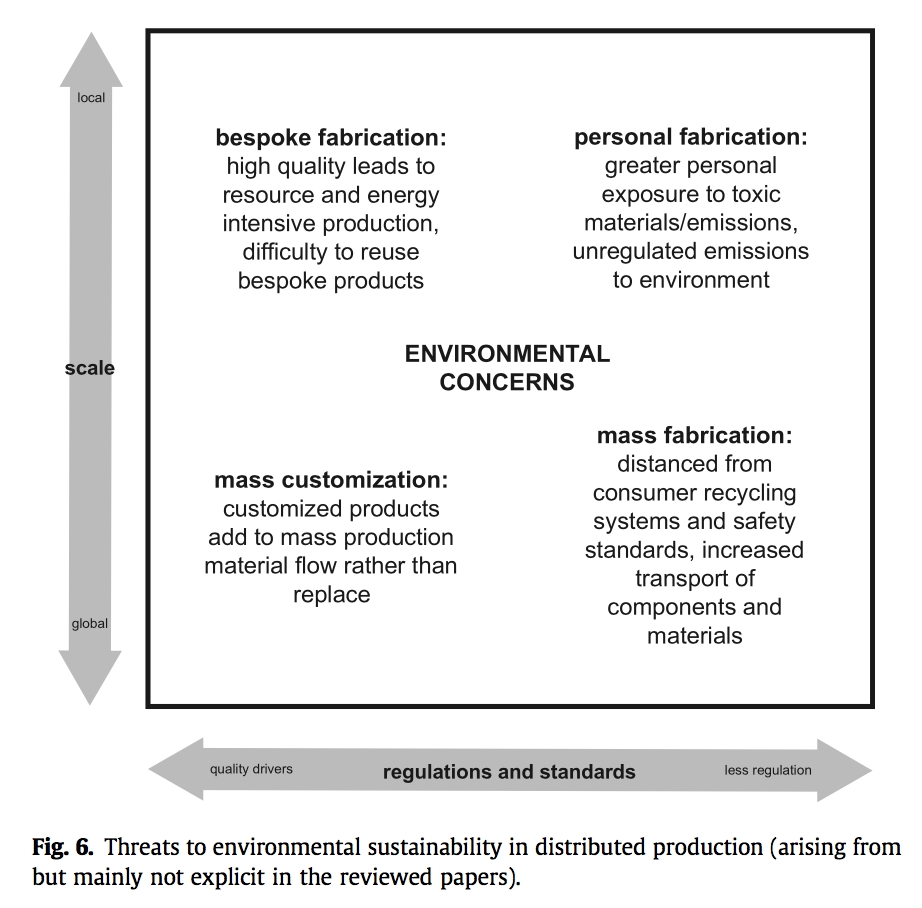
Figure 6 on page 665 in the article.
The main problem is if distributed production ends up being just another form of consumerism and over-consumption – and we don’t actually reduce resource extraction and exploitation. Considering all the issues related to global inequality and social justice, where e.g. rare earths are mined, the social implications are also clear and, as expected, intractably embedded in the environmental issues. And if we are co-producing products that are meant to last long, they need to be of high quality. Will that mean more intensive production methods? Will this balance out the fact that we are, in theory, producing fewer items? How does customization and personalization fit in with the sharing economy and resource intensity? Should we be sharing material products more? Can personalized products still be re-introduced into a re-manufacturing scheme? Which – by the way, in case you haven’t noticed – is not common practice today! Consumers need infra by which to return products into a system whereby manufacturers are incentivized to remanufacture and refurbish. And what about transport emissions? Local production would bring all kinds of benefits to a region, employment, skills, independence and resilience and so on – would these outweigh the apparent minor benefits from reducing transport emissions? Each product, material and production process has different impacts in different regions, making LCA studies challenging.
***
Russell, S.N., and J.M. Allwood. 2008. ‘Environmental Evaluation of Localising Production as a Strategy for Sustainable Development: A Case Study of Two Consumer Goods in Jamaica’. Journal of Cleaner Production 16 (13):1327–38.
This article is not about distributed production (i.e. consumer/user engagement) per se, but rather local production. I’m including it here because it seems to be a rare example of really studying the advantages and disadvantages of localizing production in terms of LCA.
To greatly abstract and summarize, some key things.
Transport impacts are not so important in the big picture in this study (using two products in analysis), whether considering primary energy use or global warming emissions. In both cases the biggest impacts come from the production of the raw materials. In other words, transporting things isn’t necessarily the biggest thing we should worry about, even if all the distributed production literature tells us that reducing transport of goods or materials is a giant benefit. And production of the raw materials is a greater consideration than production of the goods themselves (in this study, plastic bags and beds).
This means that if localizing production, one needs to look at the raw materials, not just the product production process. What is the electricity source where the raw materials are produced? What is the electricity source where the product is produced? In this study, domestic electricity was from fossil oil, which meant that localizing production would result in more global warming emissions and greater acidification. The biggest environmental benefits would come from reducing overall production and use of virgin raw materials. Is it viable to introduced recycled material? In this study the environmental burden of the product would be so much improved by using recycled material that it would balance even the emissions and impacts from recycling processes and transport. And is it possible to substitute current raw materials with (possibly local) alternative versions that have less negative environmental impact, e.g. not petroleum based?
“The country in which production activities are located is only important in terms of the technology used in production and the electricity system. If energy use in production of final goods is not significant compared to energy use in the production of raw materials, then changing the location of production to a country with a less polluting source of electricity will result in small environmental changes, if the production technology is similar” (p. 1337).
***
Hang, Melissa Yuling Leung Pah, Elias Martinez-Hernandez, Matthew Leach, and Aidong Yang. 2016. ‘Designing Integrated Local Production Systems: A Study on the Food-Energy-Water Nexus‘. Journal of Cleaner Production 135: 1065–84.
This article offers us a definition of sustainable local production.
“A local production system will comprise a non-linear structure with waste and by-products looped back into the system and synergies exploited and will require the design of the system and its components to be highly tuned to the local settings.”
“The design of local production systems considers the production of multiple products and services to satisfy local demands within the capabilities of the local environment and ecosystems (e.g. groundwater abstraction limit).”
“The problem of designing local production systems can be generally stated as:
Given a set of demands by the population in a locality and the availability of local and external resources, determine the combination of a set of processes and activities which can meet such demands so that the total cumulative exergy consumption is minimised while observing all necessary constraints.” (p. 1068)
So we need to have a good understanding of the situated, local constraints and capabilities in terms of environment and ecosystem, not only institutional issues such as existing production, resources and skills. This study focuses on food, energy and water, but production of other goods needs to consider local environmental resources and ecosystem capacities as well.
Sustainability benefits and barriers in Distributed Manufacturing
This leads us to a part of distributed production of interest to perhaps most researchers, Distributed Manufacturing. (Some prefer to call it re-distributed manufacturing, to differentiate it from a scenario where a conventional large mass producer simply distributes conventional factories round the globe. In the latter, the rich remain rich and the poor work in the factories in neo-feudalism, where all value leaves the country and returns to the corporate owner and anonymous shareholders who make money only by sitting on their comfortable asses, shifting virtual money around in funds and investments with no ethical grounds. Owners, management and shareholders are thus clean, pure and distant, not needing to dip their clean, pure, externalized profits and hands into acid, e-waste disassembly, sewing machine needles, toxic water, degraded soil, endocrine disruptors, sewage, unclean air, fatigue, under-nutrition and depression.)
***
Moreno, Mariale, and Fiona Charnley. 2016. ‘Can Re-Distributed Manufacturing and Digital Intelligence Enable a Regenerative Economy? An Integrative Literature Review’. In Sustainable Design and Manufacturing 2016, edited by Rossi Setchi, Robert J. Howlett, Ying Liu, and Peter Theobald, 52: 563–75. Smart Innovation, Systems and Technologies. Switzerland: Springer.
This is a book chapter based on a conference paper by people in my extended research network. I was intrigued by their attempt to systematically put down criteria or principles for Distributed Manufacturing, which they then compared to criteria or principles for a Circular Economy. Laying out principles or criteria based on case studies, literature and theory is a good plan of action, even if these lists can be (and regularly should be) interrogated. This project particularly includes consideration of the role of information and ‘big data’ in the transition to redistributed, circular manufacturing.
ReDistributed Manufacturing criteria:
- Localization
- Regional considerations
- Urban considerations
- On-shoring
- Off-shoring
- Geographically distributed production system
- Customization
- Mass customization
- Bespoke fabrication and information [as in my lit review]
- Mass/personal fabrication [as in my lit review]
- Tailored promotion
- Well-being and fitness
- Distributed ownership
- PSS (Product-Service System) Product Oriented
- PSS Use Oriented [note that result-oriented PSS is not included here as, the authors argue, the production system is replaced by a service]
- Distributed knowledge
- Open source, Open innovation
- Connected manufacture
- Modular manufacture process
- Craft manufacture process
- High skills development
- Distributed structure
- Supply chain integration
- Distributed retailing
Circular Innovation criteria
- Value optimization
- Human labour, skills and experience
- Health and healthcare
- Education and knowledge
- Culture and cultural heritage
- Natural capital
- Resource efficiency and sufficiency
- Water
- Energy
- Embodied energy
- CO2 emissions
- End-of-life recovery and recycling
- Reduction of transport
- Virgin materials
- Continued ownership
- Product life extension
- Longer or intensive use
- Economic viability
- Internalize the cost and risk of waste
- Regional job creation, intelligent use of human labour
- Development of a value network
When they examined their case studies, most of them belonged to a category they called ‘Distributed Products and Services’. At the other extreme would be a category of DM they called ‘Localized Products and Services’ where everything is local and highly connected. In between is a category they called ‘Connected Products and Services’ where there is a mix of on-shore and off-shore manufacturing but closer proximity to the end user than the first category. The paper concludes by emphasizing the role of ‘digital intelligence’ while recommending further research on the opportunities and challenges to DM and circular innovation, particularly (in my view) in their combination.
***
Rauch, Erwin, Patrick Dallasega, and Dominik T. Matt. 2016. ‘Sustainable Production in Emerging Markets through Distributed Manufacturing Systems (DMS)’. Journal of Cleaner Production 135:127–38.
Now we turn to the context of emerging markets and the perceived potential of sustainable, distributed manufacturing. Again we have a conceptual framework aiming to encourage further research.

Figure 3 on page 132 in the article, on drivers: reasons for the distributed manufacturing trend.

Figure 4 on page 134 in the article, on sustainability issues and related challenges in DM with regard to ‘developing’ countries / emerging economies.
Note the fourth dimension of sustainability they included: the institutional.
***
Fox, Stephen. 2015. ‘Moveable Factories: How to Enable Sustainable Widespread Manufacturing by Local People in Regions without Manufacturing Skills and Infrastructure’. Technology in Society 42:49–60.
Let’s stick to the region of emerging economies for a bit. Fox has a few papers out on this topic – and some factory and model types you may find useful – which we will get to later.
Key points here:
- characteristics of centralized industrial production (versus re-shoring, on-shoring, right-shoring, best-shoring):
- fosters disease in agricultural production
- generally involves extensive transportation that does not add value
- can only bring employment to some large countries with thinly distributed populations
- more characteristics of centralized industrial production (versus sustainable manufacturing):
- large capital investments, encouraging planned obsolescence, encouraging throwaway consumption
- “technological advanced manufacturing cannot in itself bring about the effects of meeting the needs of people and enabling people to express their potential” (i.e. social sustainability) (p. 57)
- “high barriers to people expressing their potential as production work has relied on ever higher investment (RBT) and higher education (KBV)” (p. 57)
- characteristics of moveable factories (versus centralized industrial production/advanced manufacturing):
- reduce non-value added transportation, reduce ecological impacts of throwaway consumption because investment costs are lower (no need for planned obsolescence strategies)
- “Moveable factories with established technologies bring high performance manufacturing to diverse locations including those with challenging temperatures, rough terrain, and little infrastructure. This is done without any need for new materials, intelligent robotics, or any other technologies that erect higher barriers to widespread local production by local people.” (p. 57)
- characteristics of moveable factories and distributed manufacturing versus centralized industrial production:
- lower set-up costs
- quick set-up time
- land-use benefits
- lower need/costs for storage, supply, sales, distribution facilities
- location flexibility.
***
Basmer, S, S Buxbaum-Conradi, P Krenz, T Redlich, JP Wulfsberg, and F-L Bruhns. 2015. ‘Open Production: Chances for Social Sustainability in Manufacturing’. Procedia CIRP (12th Global Conference on Sustainable Manufacturing) 26:46–51.
ABSTRACT
The participation of spatially distributed individuals in the whole production cycle is feasible through the transnational possibilities of information, communication, and production technologies. To a much greater extent than ever before value creation is generated through the use of knowledge. Open Production is a concept which enables companies to apply the criterion of openness to the whole value creation process. These new patterns of value creation (bottom-up-economics) enable the realization of small firms, which combine the three production factors – labor, ground and capital – in one stakeholder. This article addresses the social aspect of sustainability and gives an overview on the chances of micro-factories to foster social sustainability in manufacturing and redirect development efforts towards a collaboration-oriented rather than a growth-oriented approach.
This article departs from the herd somewhat, by focusing on social sustainability and mentioning the elephant in the room, growth. (gasp!) Wow. Maybe these new models of networked, distributed working-together on community activities do not need economic growth as the definition of success. D’ya think? These authors’ term for distributed production, and people’s engagement in it, is Open Production.
See the diagram below on the Value Creation Process and the access points for customers to engage in production.

Figure 1 in the article on page 47, citing as original source: Redlich T, Bruhns F-L. Open Production – a new broker-based approach to interactive value creation and user manufacturing. Proceedings of the ASME International Mechanical Engineering Congress and Exposition (IMECE) Vol. 4, Design and Manufacturing, 2008;181-189.
For these authors, bottom-up economics means taking advantage of ICT and manufacturing technologies to achieve Open Production, collaborating with customers and producers and using open source licences to increase net value creation – leading to “empowered consumers and enabled prosumers” fostering social sustainability. Thus collaboration-oriented industrialization.
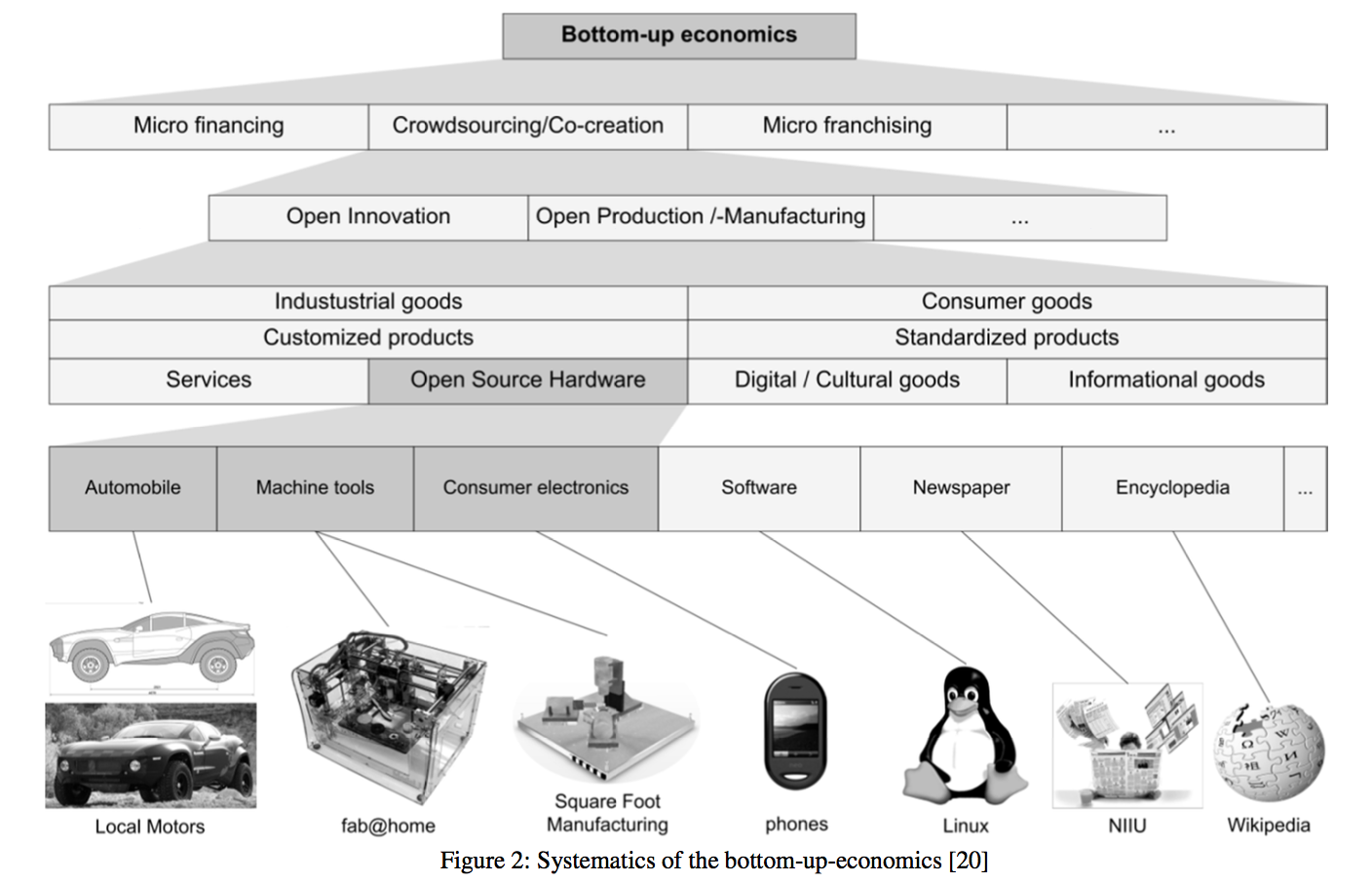
Figure 2 in the article on page 48, citing as original source: Grames PP, Redlich T, Wulfsberg JP. Open Source Hardware – Wie interaktive Wertschöpfung traditionelle Produktionssysteme revolutioniert. Zeitschrift für wirtschaftlichen Fabrikbetrieb ZWF, 5/2011;314–320.
Yes, another can and should article, citing a few examples such as Local Motors and some Fab Lab collaborations. But it could provide some footholds for someone wanting to establish some ethical and sustainability principles for open, distributed, collaborative production. Participation? Empowerment? Democratizing production? Knowledge exchange? Hm. Let’s put those DARPA Fab Labs up to that checklist, shall we? Or how about all those Chevron Fab Labs in schools in the U.S.? Are they really teaching openness and collaboration or just how to be a lackey engineer in a neo-feudal multinational in the 2020s? And did you know that Fab Foundation board members are from the DARPA labs? Do you really think they have an interest in ‘democratizing technology’ and creating a socially just, collaborative, bottom-up economy? So… we all can see where that network is going….
***
Hankammer, Stephan, and Robin Kleer. 2017 [in press]. ‘Degrowth and Collaborative Value Creation: Reflections on Concepts and Technologies’. Journal of Cleaner Production, March.
To keep us from getting too depressed and curling up in the corner in a fetal position, let’s stick with the topic of alternatives-to-growth for a moment. This article is in a forthcoming special volume of the Journal of Cleaner Production on degrowth. By the way: spot quiz. How many special issues on degrowth have there been in the key design journals (specifically Design Issues, Design Studies, International Journal of Design)? How many articles? None. Variations on alternative design and designing, or design and alternative economies, but not specifically the construct of degrowth. I find that a bit surprising.
ABSTRACT
The concept of degrowth aims fundamentally at reducing material and energy throughput equitably, while questioning the desirability of further economic growth. In order to achieve this reduction of society’s throughput, radical changes in the ways goods and services are produced, distributed and used are required. In this think piece, concepts of consumer integration into the value creation process and (new) enabling technologies are discussed as possible constituting elements of alternative organizational models in a degrowth society. To date, collaborative value creation concepts, such as crowdsourcing and mass customization, have been discussed almost exclusively as business model patterns for companies in economies that are set to grow. The same applies to the assessment of (new) technologies, such as additive manufacturing, web-based user interfaces for co-creation, and other flexible production technologies that allow for collaborative and individualized production. Potential positive and negative effects of these concepts and technologies with regard to the objectives of degrowth are discussed in order to initiate a debate about the inclusion of CVC for the design of alternative organizational models that are in line with degrowth thinking. This think piece illustrates that several elements of collaborative value creation and its enabling technologies coincide with degrowth objectives but do not lead per se to their attainment. Thereby, a starting point for future (empirical) work in this area is generated.
Yes, another can-and-should piece, this one trying to connect degrowth literature with management literature. And more acryonyms. Collaborative Value Creation for these authors is similar to the previous article: use enabling tech to create value networks where people and groups collaborate on production (e.g. commons-based peer production, mass customization, innovation toolkits, crowdsourcing, crowdfunding). With regard to degrowth and its objectives or requirements, the authors pinpoint these 5 things as connecting the collaborative value thing with the degrowth thing:
- Reduction of overproduction and obsolete production capacity
- Extending the meaningful lifespan of products
- Sufficient consumption
- Resilient and self-sufficient local economies
- Collective and democratized downscaling.
The first two “serve as two indicators for the potential to contribute to the reduction of energy and material throughput demanded by degrowth” (p. 3) and the third complements this. The final “two objectives concern desirable social changes” (p. 4).
With regard to number 1, the article states the common trope that “crowdfunding prevents products with no interest of the community to be financed” (p. 4). But that means we should look at what is being crowdfunded, given that Kickstarter etc. appears to launch largely gadget-y projects. (I haven’t looked at Kickstarter or Indiegogo studies yet, even though by now there must be plenty.) One wonders if these crowdfunded projects just add to the commercialism of the maker movement and therefore don’t dematerialize our wealthy lifestyles – just as many projects in Fab Labs and makerspaces are gadget-y and hobbyist. Our home-grown version of crowdfunding and –sourcing in Finland, Mesenaatti, has an explicitly cultural framing and therefore attracts more interesting projects in which to get involved, often of a bigger scale or timeframe than just another techy product. The Innonatives platform also explicitly links sustainability with open innovation. Several studies are being conducted now on this platform and on crowd-design for sustainability. I look forward to those studies. (I think we need to look at these new types of design activities in another post, from designing crowd-design initiatives to designing for degrowth.)
***
Srai, Jagjit Singh, Mukesh Kumar, Gary Graham, Wendy Phillips, James Tooze, Simon Ford, Paul Beecher, et al. 2016. ‘Distributed Manufacturing: Scope, Challenges and Opportunities’. International Journal of Production Research 54 (23):6917–35.
An article with empirical case studies, an expert panel as well as some orientation to sustainability (including ‘resilience’). The article argues that Distributed Manufacturing as a concept is wider than Industrie 4.0 or Smart Manufacturing because of greater participation in the value chain and end-user engagement. It also differs from pre-industrial artisanal models because “multiple people including end users can come together and do things in a codified way, making things through quantified processes” (p. 6919, my emphasis). This is an important point. “This paradigm has a locational element, a value element and a technology element” (p. 6919).
The authors sum up:
“The emerging characteristics of DM include:
- Digitalisation of product design, production control, and demand and supply integration that enable effective quality control at multiple and remote locations
- Localisation of products, point of manufacture, material use enabling quick response and just-in-time production
- Personalisation of products tailored for individual users to support mass product customisation and user-friendly enhanced product functionality
- New production technologies that enable product variety at multiple scales of production, and as they mature, promise resource efficiency and improved environmental sustainability
- Enhanced designer/producer/end user participation, unlike the world of the artisan, enabling democratisation across the manufacturing value chain” (p. 6922).
Some specific sustainability opportunities mentioned:
- Re-capturing valuable materials
- Utilise any spare capacity
- Manufacturing will no longer be informed by a particular organisation or group context
- Improved quality but more informed QA practices based on advanced understanding of kinetics, processing
- Reduced solvents in manufacturing will reduce greenhouse gas emissions.
Perhaps it would be a useful exercise as a next step to go through each of these characteristics and pin them to specific sustainability indicators. How exactly does digitalisation drive ‘sustainability’? Localisation? Personalisation? New production technologies? More participation? What is the low-hanging fruit and where are the biggest potential impacts?
Typologies of (Re)Distributed Manufacturing
Let’s now turn to types and models of Distributed Production. I mentioned my proposed constructs earlier, which I based on axes of large to small scale, for one, and on the agency of the consumer in design and production, for the other: from producer-controlled design and production to peer-to-peer production. In the LeNSin project, we are playing with different axes or considerations (e.g. if a DE model or case study is decentralized or distributed, if it is a B2B offer or a B2C offer). In the previous LeNSes project, which dealt specifically with Distributed Renewable Energy solutions as sustainable Product-Service Systems in southern Africa, solutions were also seen as stand-alone or grid/network. Moreover, in a recent article by Massimo Menichinelli examining Open Design and Distributed Design, a further model of diffused is proposed.*
*See Menichinelli, Massimo. 2016. ‘A Framework for Understanding the Possible Intersections of Design with Open, P2P, Diffuse, Distributed and Decentralized Systems’. Disegno: Journal of Design Culture 1–2:44–71.
***
Emili, Silvia, Fabrizio Ceschin, and David Harrison. 2016. ‘Product–Service System Applied to Distributed Renewable Energy: A Classification System, 15 Archetypal Models and a Strategic Design Tool’. Energy for Sustainable Development 32:71–98.
This is a key article that came out of the LeNSes project. The study aims to understand the relationship between sustainable Product-Service System models and Distributed Economies models in renewable energy, in order to foster more solutions, and more democratic access to energy, in emerging economies.
Their axes consider the following characteristics:
- the energy system (e.g. stand-alone, kit, grid connected);
- the value proposition and payment structure (from sales model to service model);
- the value proposition and payment structure in terms of PSS (product-oriented, use-oriented or result-oriented);
- the mode of capital financing (fully subsidized to commercial based);
- the ownership of the energy system and that of the product, from user to producer;
- the organizational form, e.g. public sector, NGO or private sector;
- the operation of the energy system and the product, from user to provider;
- the target customer (from individual to community);
- the provider-customer relationship (from transaction-based to relationship-based); and
- the environmental sustainability potential (from low to high).
This very detailed analysis allows for the complexity of energy solutions, as well as being able to capture what are new and innovative models. First the authors designed the depiction of the axes in building a classification system.
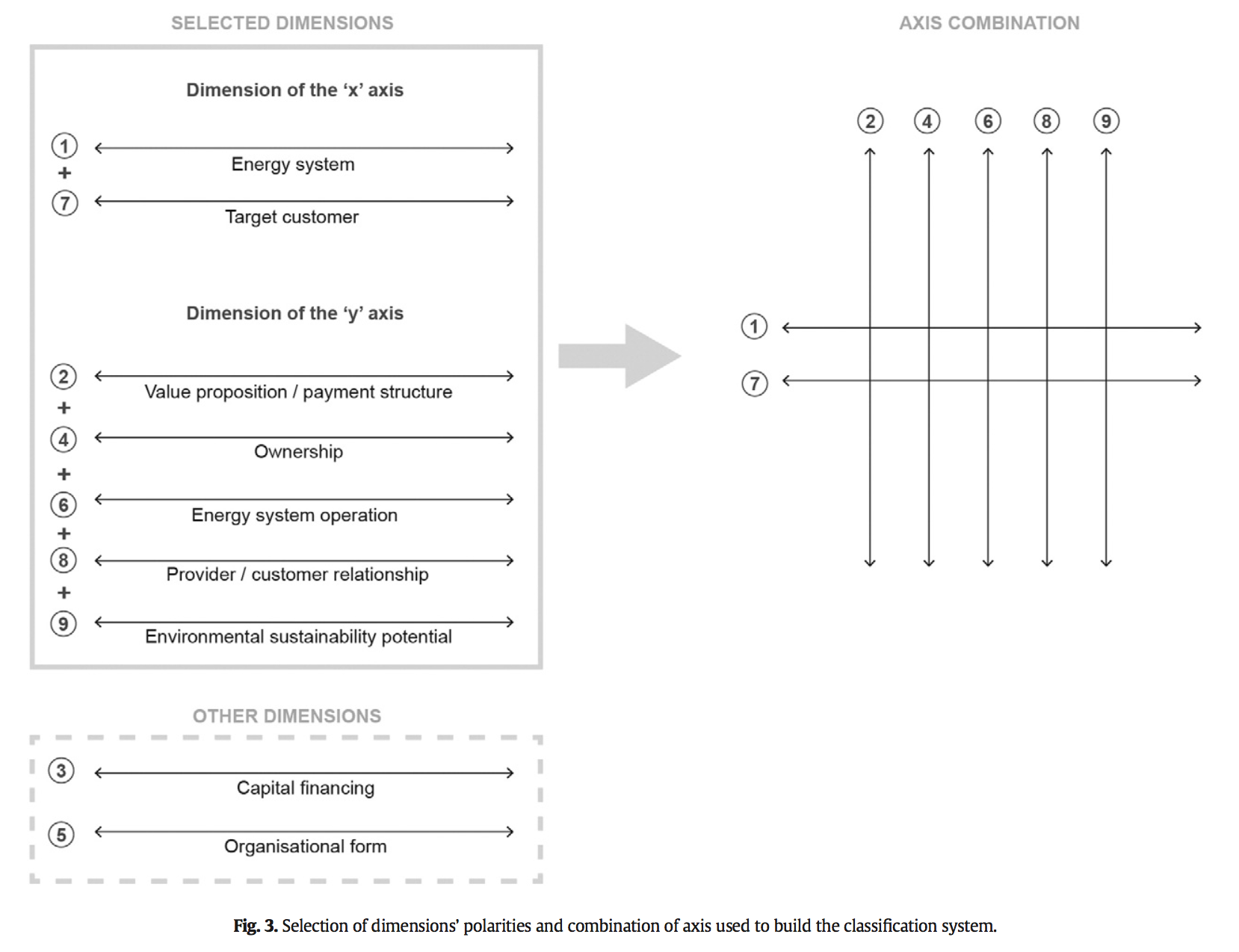
Figure 3 in the article on page 79, placing the axes.
A well-designed and –visualized classification system then incorporates many characteristics without becoming confusing.
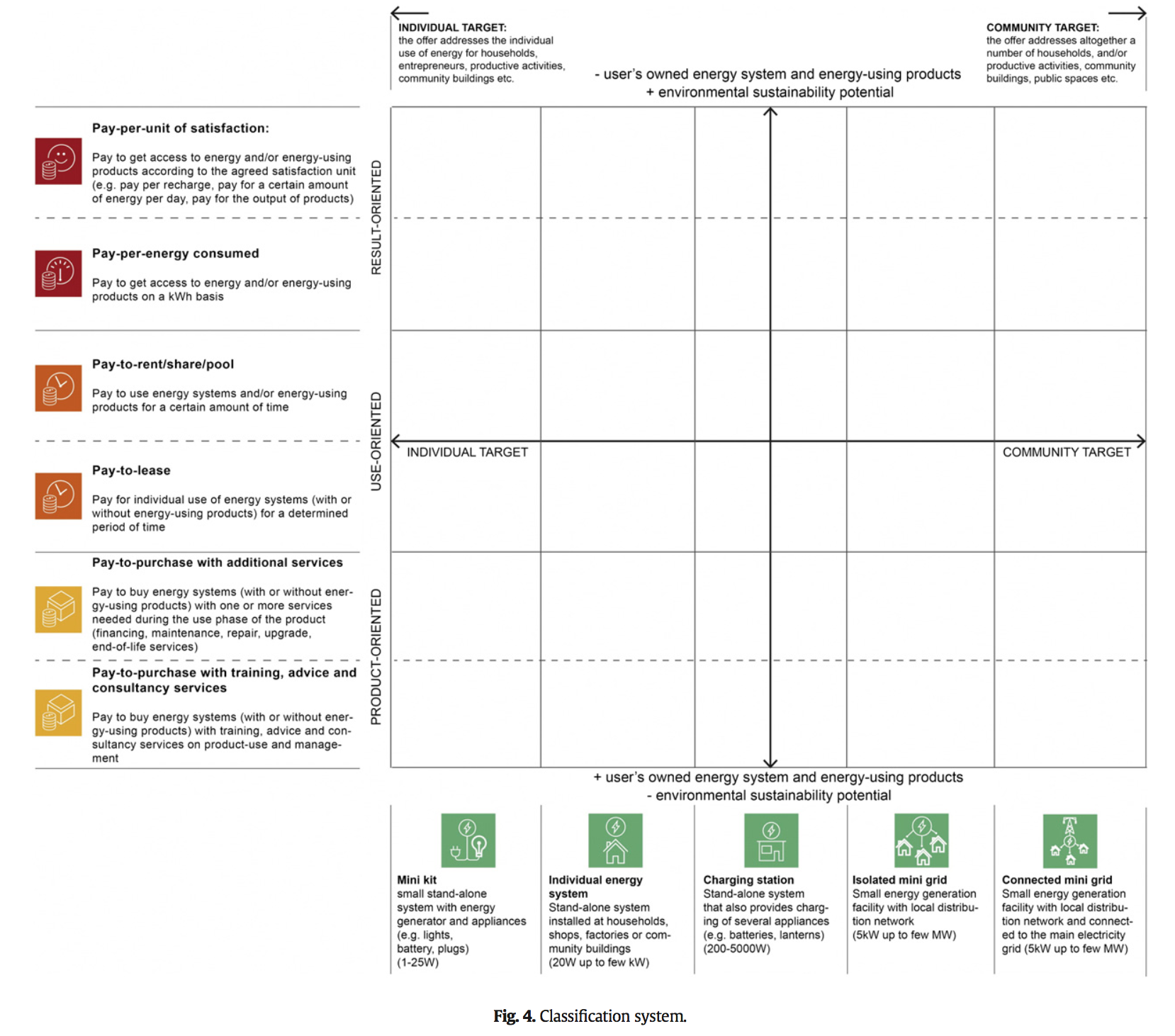
Figure 4 in the article, on page 80.
The researchers were then able to classify their case studies and came up with 15 archetypal models. The classification system can be used with e.g. managers to consider and position their own offerings, and to identify new business opportunities (and this was tested in the field with practitioners).
***
Waldman-Brown, Anna. 2016. ‘Exploring the Maker-Industrial Revolution: Will the Future of Production Be Local?’ BRIE Working Paper 2016-7. University of California Berkeley: Berkeley Round Table on the International Economy.
This Working Paper discusses different concepts in the ‘new industrial revolution’.
1. Distributed Production
A. Who owns what?
The paper suggests three possible ownership models in large volume, small batch production:
- Fab Cities: small-batch, locally-created and locally-controlled production at a citywide level;
- Vertically-integrated SMMs (Small and Medium Manufacturers): local production capabilities integrated into large, networked systems;
- Business as usual: large factories dominant, SMMs and artisanal workshops as niche.
B. What’s the scale of production?
The paper argues that small does not necessarily mean local, small factories may also produce large amounts, and of course manufacturers’ profit models might favour large-scale production.
C. Where does manufacturing happen?
Economically, what makes sense to produce at large volume and what locally in small batch production? What aspects of production could and should be localized? What about the role of policy – import taxes and protectionist policies? Will global warming and material scarcity actually affect supply chains, as ‘idealists’ claim?
D. How do SMMs interact?
A platform or networked economy of ‘smart’ SMMs enabled by all sorts of technologies might nevertheless cause concerns for e.g. quality control.
2. Personalized Production
One-off, artisanal products indicate wealthy consumers. Moreover this kind of engagement in production, prosumption, as indicated in DIY maker activities, is time consuming and skill intensive. Personalized production appears suitable for products as ‘experiences’, personalized medical devices and products needed in disaster zones.
3. After market repair and customization
“Although repair is quite different from customization in practice, we combine the two aspects here in order to discuss local after-market servicing and product modularity” (p. 16). This concept is particularly attached to the maker movement. Again, the paper expresses scepticism about the ideal espoused regarding diffusion of repair and customization, activities that are common in emerging countries but not highly industrialized ones, pointing rather to examples of lease models where the product ownership is retained by the manufacturer (which of course is a result-oriented PSS in the language we use in S.PSS study). The manufacturer is incentivized to maintain the product but the design may not be open. Nor are repairable products the norm in complex products. And none of this means that things need to be or will inevitably become localized.
In all, the paper brings up many crucial realities and critical points that us sustainability romantics purposefully avoid. Money still talks and business-as-usual is a huge ship that is challenging to turn. Anna has gone on to create a typology matrix of her own that is in progress – I’ll include it when it makes its way into a Working Paper or article I can cite.
My main concern with the paper is the grounding assumptions, and here we have the assumption clash. On the one hand, the mainstream argument is that large-scale production will continue when it is the most economically viable choice. The assumption is that what is being produced now must continue to be produced in some form. But the whole point of Distributed Economies is to stimulate re-awareness of what is being produced and why. Just because you have set up a zillion zillion-square-metre factories everywhere doesn’t mean humanity needs what you are producing. You are actually pushing this production onto humanity through marketing gimmicks, psychological warfare and planned obsolescence in order to recoup the costs of the factory tooling, inventory and so on. By the same token, those of us who romanticize local and distributed production claim that only what is needed will be produced. The assumption is that production-on-demand fosters both environmental and social sustainability. But again, when we look at the global North version of the DIY maker movement, only a tiny fraction addresses issues and solutions that are not some geek, hobbyist, adult-toy crapject. And that leads us nicely into the moral swamp of things that are fun, creative, explorative and without clear function – and the swamp of needs, wants and desires. Suffice to say at this point, question all assumptions and allow critical reflection and dialogue. We have no idea where we are, but we are building the future together and there are no defaults we must resort to.
***
Fox, Stephen, and Päivi Vahala. 2016. ‘Strategic Design of Innovative Production Systems: Strategic Design Symbol System v.1’. VTT Technology 270. VTT Technology. Espoo, Finland: VTT Technical Research Centre of Finland.
This report pulls together more useful considerations in the form of a game one can play with stakeholders or students to discuss Special Production. Please respect the authors’ copyright on the icons.
The game or workshop has recommended steps.
First, identify the geographical area of interest, whether a region, city, town or village. Where – in this area in question – should innovative manufacturing be located?
Then discuss what value should be added.

Game pieces in the system for ‘Value Added’:
Demographically Distributed Economy; Geographically Distributed Economy; Disintermediation; On-shoring; Localization, Ecological renewal; Creates New Markets; Up-cycling; Down-cycling; Re-cycling.
Next, value chain. What type of value chain will your innovative factories contribute to?
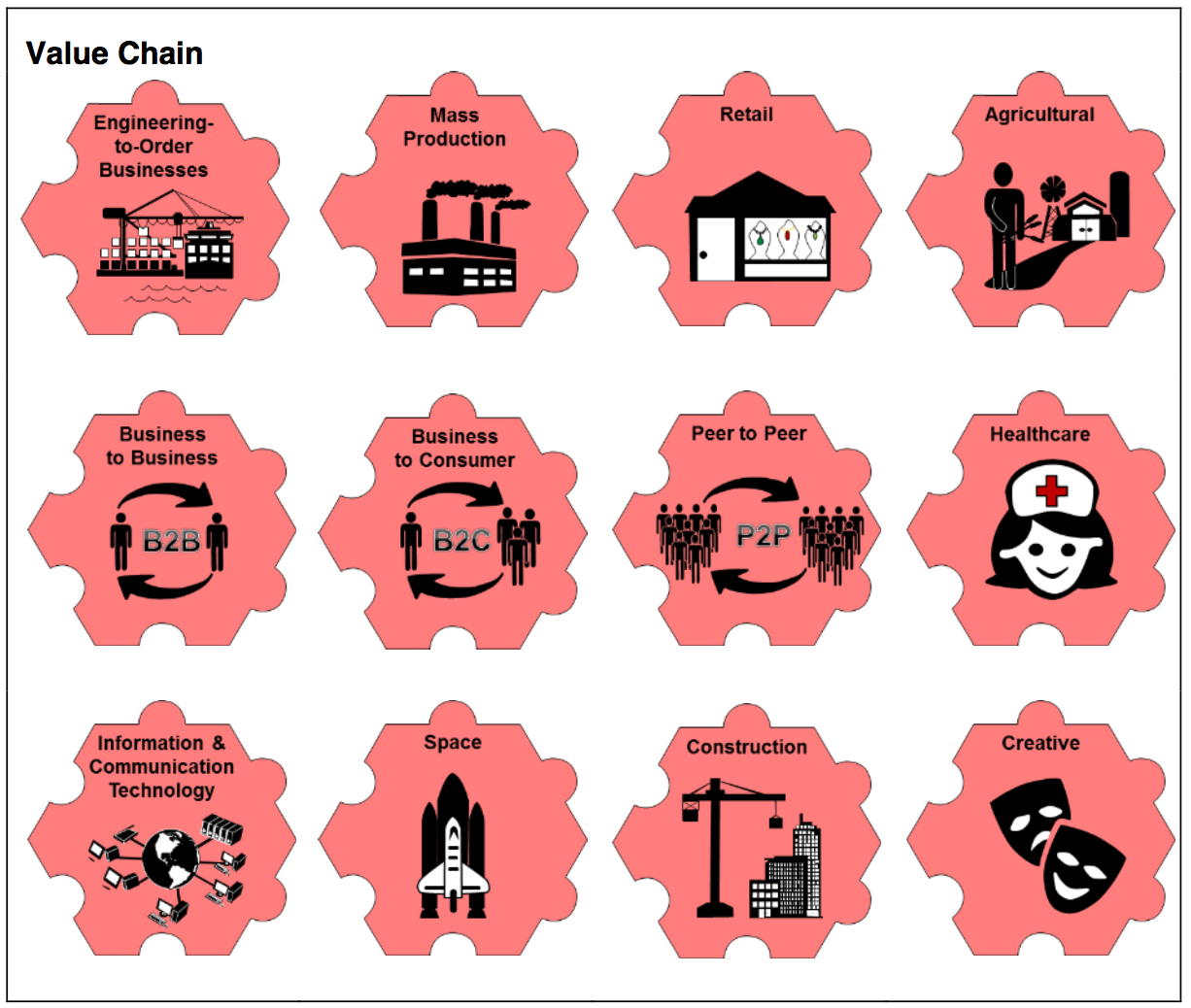
Game pieces in the system for ‘Value Chain’:
Engineering-to-Order Business, Mass Production, Retail, Agricultural, Business to Business, Business to Consumer, Peer to Peer, Healthcare, Information & Communications Technology, Space, Construction, Creative.
Then talk about materials and resources. What resource inputs are needed? What raw materials? Is there capacity for recycled materials? Open source hardware? Components – and so on?
Next, infrastructure inputs. Computer skills? Manual skills? Digital infrastructure, water infra, etc.?
Then discuss what kinds of factories could be used in this region. What factory types would benefit the region and are best suited there?

Game pieces in the system for ‘Types of Factory’:
Carry-able Factory; Mobile Factory; Moveable Factory; Home / Club Factory; Independent Local Factory; Networked Local Factory; Factory Kits for Export; Fixed Factory.
Finally, discuss how many new jobs should be created in your innovative production system. One to five? Up to 50? More than 50? More than 250? And what time scale should you consider? Can you implement your production system in less than a year? In 3 years? More than 5 years?
The pieces can be linked together to be able to visualize the different elements – as well as interlinking systems.

Linking the game pieces in dialogue and exploration.
The report gives examples of how the game system has been used. Some of us have used the game in workshops with students; I used it with students in Mexico City in 2016 and adapted it somewhat to incorporate Design-for-Sustainability principles and sustainable Product-Service Systems elements. It was helpful for both me and the students to think about what now exists in their local context – for them to describe some case studies on Distributed Economies to me – and to identify some innovative solutions to existing problems, by playing around with various value-added and value-chain models.
Summary
There are still several references I could have added, but I think this well represents some of the work on Distributed Production and its sustainability implications. We still are doing too much could-be-should-be, and we need to start looking at empirics and identifying indicators that tell us where we’re going. There is general agreement that (a) the production we are interested in examining involves people and organizations in new ways, new networks and new agencies; (b) it exploits current technological solutions but also develops them (including new p2p practices); and (c) it has socio-environmental potential – that is, it has potential to dematerialize well-being, change values related to consumerism and reduce the negative impacts of mass production and overconsumption. On paper there would seem to be so many benefits to making production more local, in reaction to the negative impacts of globalization, particularly on marginalized regions. But from a purely environmental assessment viewpoint, the benefits are not so clear and more research on material flows would be welcome.
This also applies to what kind of production we are discussing: in Europe, at least, food and housing (e.g. heating in Finland) embodies huge impacts that overshadow negative impacts from consumer goods. In this context, the DIY maker movement is a drop in the ocean, unless we imagine a pathway that includes more knowledge building and more agency for everyday citizens – from goods-and-gadgets production to energy production, food production, involvement in urban development and place-making, impact on transport and mobility and so forth.
DIY making is already being seriously co-opted and enclosed by private interests, even while it spreads to other domains and communities such as urban agriculture. We want new and better prosumption patterns, but we also want new ways to value success – new economic models that make hypercapitalism and the current rise in neo-feudalism obsolete. We want to ‘democratize technology’, but that requires a constant conversation on what that really means in practice. Not every space for distributed production (e.g. a makerspace, a mini-factory) needs to strive for universal access or every citizen as a user, but instead they can be more strategic in their aims and in their means. As participants asked in a workshop held on ‘sustainable making’ in London in October 2015, if a makerspace is the answer, what is the question?*
*For more on this workshop, see Smith, Adrian, and Ann Light. 2017. ‘Cultivating Sustainable Developments with Makerspaces’. Liinc Em Revista 13 (1):162–74.
There is still a gap between people interested in p2p dynamics and the ‘open’ paradigm (open hardware, open design, etc.), and people interested in distributed manufacturing, the sharing economy and so on, where incumbent business still has a key role. Or to be more exact, it is not clear what the relationship is, particularly if taking socio-environmental sustainability and resilience into account. Some research ignores p2p communities, activities and practices that may be playing a significant role in how ‘distributed production’ or the ‘new industrial revolution’ plays out, particularly as sociotechnical configurations that are embedded in communities. There is a lot of ‘social movement’ type messiness and mobilizing according to ideology in these grassroots activities that make some uncomfortable. In contrast, other research ignores the current marginality of distributed production (in relation to mass production and the trajectory of industrialization), which means that actual activities, by enterprises, organizations or individuals in distributed production – with real barriers to longevity, vulnerabilities to co-optation, shifting allegiances, even (gasp) politics – are not spelled out, in favour of conceptual frameworks or examinations with a tiny unit of observation.
I don’t think we know yet what contributes to a makerspace’s longevity, how maker communities navigate from commercial to civic duties and back again, what factors contribute to a space’s or community’s downfall, what varied roles the spaces play in their wider (urban or rural) neighbourhoods, and even what knowledge we can derive from such stories – and how to act on it.
Neither do we have much of a sense of what we are losing or gaining with changing manufacturing activities and locations. Who is actually engaging more with end-users in design and production, beyond the always-used, exemplar case studies, and are there wider social and environmental impacts detected? How are materials moving around? What role does gentrification and land-use planning play – how can a city support its creative sectors and particularly those oriented to sustainability?*
*See Ferm, Jessica, and Edward Jones. 2016. ‘Beyond the Post-Industrial City: Valuing and Planning for Industry in London’. Urban Studies 54 (14):3380–98.
How can we zoom in and out in scale and over time in order to understand the relationship among ‘resilience’, new production modes and citizen engagement? Will bringing production into cities only engage the already privileged, who have the technological skills needed as employees, who can afford high rents as owners and who can afford bespoke products as customers? How do we truly foster new ways to value exchanges, to corrode the current neoliberal dominance of market value as the ruler for everything? We have a lot of work to do.
***
Do you want a pdf of this text? Localizing_distributing_production_Kohtala2017.


